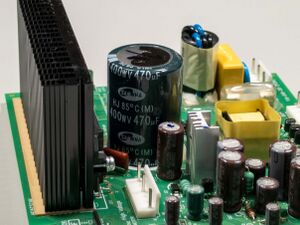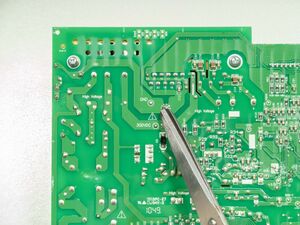Mains Power: Difference between revisions
(Add Safety Components section stub) |
(Rewrite section about 'Filter Caps') |
||
| Line 7: | Line 7: | ||
TODO - Document methods of determining a live chassis in an unpowered state. | TODO - Document methods of determining a live chassis in an unpowered state. | ||
== | == Mains Voltage Capacitors == | ||
[[File:HT-PCB-140-08058A-P-V06-main-hv-cap.jpg|thumb|Rectified mains bulk capacitor in a combined VFD and SMPS that can store 37 J]] | [[File:HT-PCB-140-08058A-P-V06-main-hv-cap.jpg|thumb|Rectified mains bulk capacitor in a combined VFD and SMPS that can store 37 J]] | ||
[[File:HT-PCB-140-08058A-P-V06-main-hv-cap-verify-safe.jpg|thumb|Verifying capacitor is discharged with a metal tool before touching]] | [[File:HT-PCB-140-08058A-P-V06-main-hv-cap-verify-safe.jpg|thumb|Verifying capacitor is discharged with a metal tool before touching (plastic handled scissors)]] | ||
=== Voltages Present on Mains Bulk Capacitors === | === Mains Bulk Capacitors === | ||
Mains bulk capacitors are present in many new and old devices, most notably the vast majority of general purpose AC-to-DC power supplies are SMPS (Switch Mode Power Supplies), those power supplies rely on rectifying the mains input voltage from AC into DC which is stored in bulk capacitors. This is done to allow a transistor to switch this DC through a transformer at much higher frequencies (often 100 kHz to 1 MHz) than the grid (50 or 60 Hz), this allows the magnetics (eg. transformer) in the power supply to be smaller, lighter, cheaper and more efficient. However those mains voltage bulk capacitors can be rather large on high powered devices to improve regulation performance and increase hold-up time during grid brownouts, because of this those large mains voltage capacitors can pose a shock hazard even after the device has been powered off due to the charge stored in those capacitors. | |||
==== Discharging Mains Bulk Capacitors ==== | |||
Most modern devices include bleeder resistors to discharge those capacitors however this can take tens of minutes and those resistors can fail. '''Because of this you should always discharge mains bulk capacitors before touching a PCB after it has been powered on.''' To discharge a capacitor manually use an insulated tool such as plastic handled pliers to place a resistor (10 to 100 kΩ) directly across the pins of the capacitor, this will discharge the capacitor over several seconds and avoid damaging the capacitor or metal tool due to a sudden discharge. After this step or on devices where you can visually identify the bleeder resistor across the capacitor and have confidence it is functional you can then bridge the capacitor pins with a metal tool directly. If the device is not connected to earth ground, a non-insulated metal tool can be used as a circuit cannot be made through you however this is generally discouraged. | |||
==== Voltages Present on Mains Bulk Capacitors ==== | |||
TODO | TODO | ||
*V AC often means Vrms AC, 230 Vrms AC will be 325 Vp AC | *V AC often means Vrms AC, 230 Vrms AC will be 325 Vp AC | ||
*Devices with active PFC will have boosted voltages sometimes up to 400 V DC | *Devices with active PFC will have boosted voltages sometimes up to 400 V DC | ||
== Safety Capacitors == | === Safety Capacitors === | ||
TODO | TODO | ||
*Those are called safety capacitors because their failure can result in parts the user can touch becoming live at mains voltage. | *Those are called safety capacitors because their failure can result in parts the user can touch becoming live at mains voltage. | ||
Revision as of 05:18, 9 February 2022
Mains power (sometimes mains or line) refers to the AC power at the final stage of the electrical grid that is run into most buildings and is available at wall outlets. The voltage used varies throughout the world however in North America the standard is 110 - 127 V AC while Europe is 220 - 240 V AC. There is significant danger in coming into contact with mains as the only limit to the current is a breaker or fuse in the service box for the building which is designed to prevent damage to the building's wiring, not prevent damage to connected devices or electrocution. As such devices with exposed mains power have inherent hazards when they are powered.
Live or Hot Chassis
Some devices such as CRT displays or televisions or radios may have been designed with a live chassis that is connected to mains power. This means touching the chassis while having contact with either neutral or earth ground can complete a circuit and result in a significant electrical shock. These also pose a hazard for diagnostics and can lead to other difficulties such as finding a suitable DC ground reference for taking measurements.
TODO - Document methods of determining a live chassis in an unpowered state.
Mains Voltage Capacitors


Mains Bulk Capacitors
Mains bulk capacitors are present in many new and old devices, most notably the vast majority of general purpose AC-to-DC power supplies are SMPS (Switch Mode Power Supplies), those power supplies rely on rectifying the mains input voltage from AC into DC which is stored in bulk capacitors. This is done to allow a transistor to switch this DC through a transformer at much higher frequencies (often 100 kHz to 1 MHz) than the grid (50 or 60 Hz), this allows the magnetics (eg. transformer) in the power supply to be smaller, lighter, cheaper and more efficient. However those mains voltage bulk capacitors can be rather large on high powered devices to improve regulation performance and increase hold-up time during grid brownouts, because of this those large mains voltage capacitors can pose a shock hazard even after the device has been powered off due to the charge stored in those capacitors.
Discharging Mains Bulk Capacitors
Most modern devices include bleeder resistors to discharge those capacitors however this can take tens of minutes and those resistors can fail. Because of this you should always discharge mains bulk capacitors before touching a PCB after it has been powered on. To discharge a capacitor manually use an insulated tool such as plastic handled pliers to place a resistor (10 to 100 kΩ) directly across the pins of the capacitor, this will discharge the capacitor over several seconds and avoid damaging the capacitor or metal tool due to a sudden discharge. After this step or on devices where you can visually identify the bleeder resistor across the capacitor and have confidence it is functional you can then bridge the capacitor pins with a metal tool directly. If the device is not connected to earth ground, a non-insulated metal tool can be used as a circuit cannot be made through you however this is generally discouraged.
Voltages Present on Mains Bulk Capacitors
TODO
- V AC often means Vrms AC, 230 Vrms AC will be 325 Vp AC
- Devices with active PFC will have boosted voltages sometimes up to 400 V DC
Safety Capacitors
TODO
- Those are called safety capacitors because their failure can result in parts the user can touch becoming live at mains voltage.
- Things like X and Y class safety capacitors must be replaced with proper safety capacitors of equivalent type, not just any random film or ceramic capacitor.
Earth Leakage Safety Devices
TODO